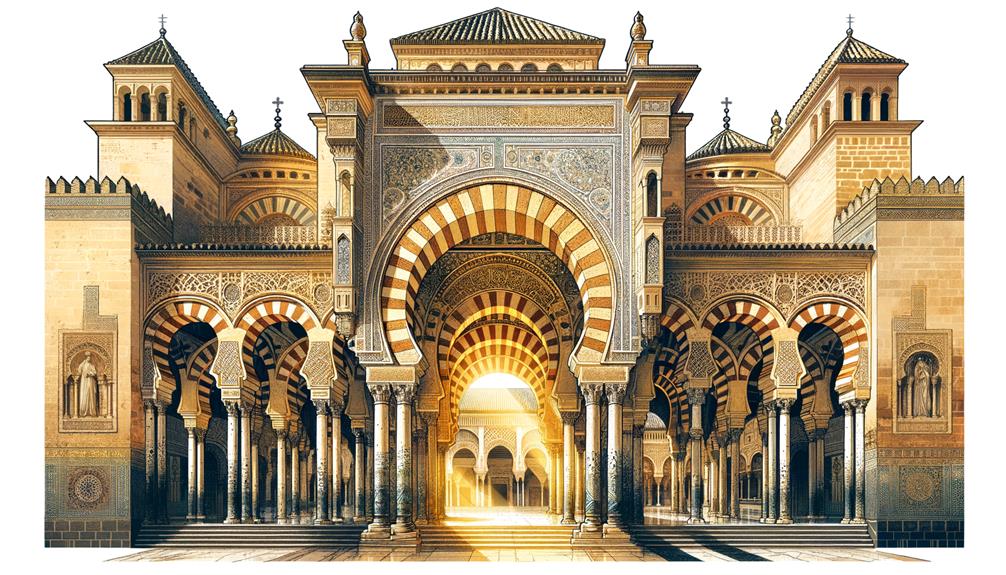As I stepped into the Córdoba Mosque, I felt like I was walking into a rich tapestry of history, art, and spirituality. The early morning light cast a warm glow on the arches, making them seem like silent guardians of the past. I quickly realized that visiting at the right time was crucial – not just for the visual spectacle, but for the peaceful atmosphere that allowed me to fully absorb the intricate beauty around me. With every step, I uncovered new details waiting to be discovered. This ancient masterpiece holds many secrets and architectural wonders – what stories will it reveal to me?
Visiting Hours and Tickets
When planning your visit to the Córdoba Mezquita, keep in mind that the hours vary between the busy season (March to October) and the quieter period (November to February). This flexibility allows for a more personalized experience depending on the time of year. Before you go, check the official website for the most up-to-date information on visiting hours.
Buying tickets is straightforward, whether you purchase them online through the official website or at the on-site kiosk. I recommend opting for guided tours, which provide fascinating insights that might otherwise be overlooked. If you're short on time, consider the 'skip the line' option to avoid long queues.
Audio guides are available for those who prefer to explore at their own pace. I find that visiting in the late afternoons creates a stunning atmosphere inside the Mezquita, as the changing light highlights the intricate details. If you're looking for a unique experience, consider the night visits, when the Byzantine and Arabic designs are beautifully illuminated, offering a fresh perspective on this historic masterpiece.
Best Time to Visit
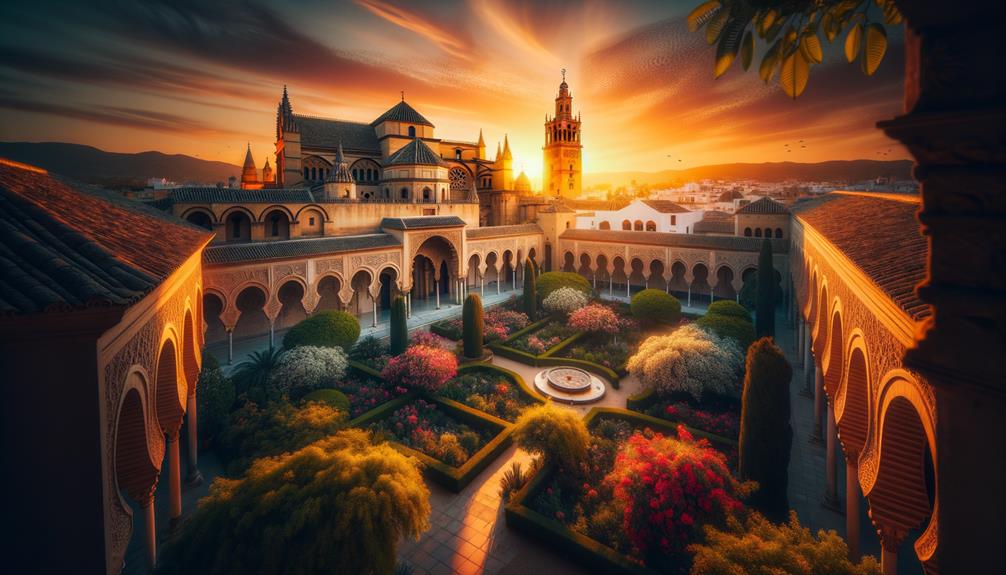
When I visited the Córdoba Mosque, I found that early mornings offered a peaceful atmosphere, free from the usual crowds. Late afternoons had a different charm, with the soft sunlight casting beautiful shadows. At night, despite some photography restrictions, the mosque took on a mesmerizing new quality.
Early Morning Benefits
Taking an early morning stroll through the Córdoba Mezquita, I felt a deep sense of calm wash over me as the golden light transformed the monument into a breathtaking sanctuary. The peaceful atmosphere allowed me to fully appreciate the architectural marvels that stood before me, and the limited access to the Cathedral portion of the Mezquita added to the sense of exclusivity and intimacy.
As I walked through the tranquil hours, I felt a strong connection to the history and craftsmanship embedded in every arch and column. The morning light cast a warm glow on the intricate details, highlighting patterns and designs that might have otherwise gone unnoticed. Despite being surrounded by other early risers, there was a sense of shared reverence among us, each of us absorbed in the beauty and grandeur of the space.
Afternoon Experience
Afternoon visits to the Córdoba Mezquita offer a serene atmosphere, allowing for a more intimate connection with its stunning architecture. As the sun casts a warm glow through the arches, the experience becomes almost meditative. The peaceful ambiance invites you to slow down and truly appreciate the intricate details that adorn this historical gem.
By visiting in the afternoon, you avoid the crowds of tourists that fill the space during peak hours. With fewer people around, you have the freedom to explore the expansive hallways at your own pace, marveling at the unique blend of Islamic and Christian influences without feeling rushed.
The full access granted in the afternoon ensures that you won't miss any part of the Cathedral's grandeur. As you stroll through its sacred spaces, each corner whispers tales from centuries past, bringing the historical richness of the Mezquita to life. This quieter time of day provides the perfect backdrop to reflect on the monument's storied past and its architectural marvels, making your visit a deeply personal journey.
Night Visit Highlights
The Night Visit at Cordoba's Mezquita is a truly otherworldly experience. As I walked through the vast, silent halls, the atmospheric lighting cast mesmerizing shadows and highlighted intricate details. The ambiance felt almost sacred, amplifying the monument's religious significance and deep historical roots.
During this exclusive experience, I was captivated by the interplay of light and shadow, which offered a fresh perspective on the Mezquita's art and history. The arches, columns, and mosaics seemed to come alive, each bathed in a soft, mystical glow. With photography restrictions in place, I was able to fully immerse myself in the experience, taking in every detail without distraction.
The Night Visit is not just about seeing the Mezquita; it's about feeling its essence. The lighting effects create an atmosphere that inspires introspection and wonder. It's a moment to connect with the past, to feel the weight of centuries of faith and artistry. For those seeking a break from the ordinary, this experience offers a rare glimpse into the heart of this historic wonder. If you ever have the chance, don't miss this unforgettable journey into the soul of the Cordoba Mezquita.
Guided Tours

For those interested in uncovering the rich history and artistry within the Córdoba Mosque, guided tours offer a unique journey through its fascinating past. By opting for group tours, I can skip the line, making the most of my visit without the hassle of queuing. Entry tickets often come paired with audio guides, providing an informative companion that complements the expert guides leading the tours.
The guided tours take a deep dive into the historical evolution of the mosque, tracing its transformation from an Islamic mosque to a Christian cathedral. The expert guides highlight the cultural integration that defines this monument, pointing out the seamless fusion of Islamic, Christian, and Gothic elements. I find myself fully engaged by the architectural significance of the Mezquita, appreciating the intricate details that tell a rich story of history and artistry.
As I listen to the guides, I reflect on the cultural symbiosis that the Mezquita embodies. The expert commentary brings the historical narratives and architectural wonders to life, making the experience profoundly enlightening. Each guided tour offers a distinct perspective, making the exploration of the Córdoba Mosque an unforgettable journey through time and culture.
Key Features to Explore
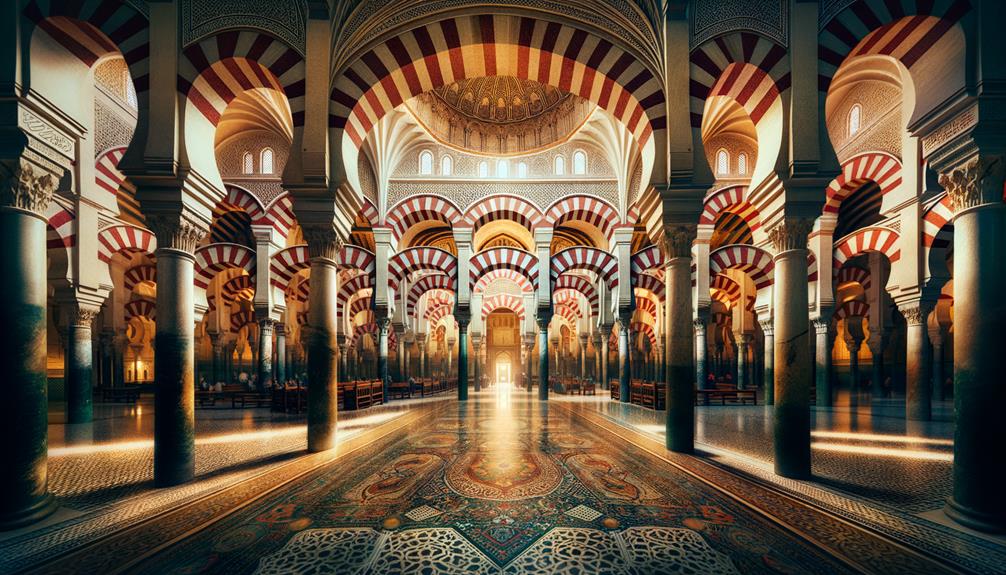
As I wandered through the Mezquita, each step revealed a new wonder. The intricate arches of the Mihrab and the serene beauty of the Patio de los Naranjos left me in awe. The blend of Islamic, Christian, and Gothic elements tells a story of centuries-long cultural integration. Hidden gems like Roman mosaics beneath the mosque whisper secrets of the past. These architectural highlights and historical artifacts make the Mezquita a living museum, capturing the essence of Córdoba's rich heritage.
Architectural Highlights
Stepping into the Mezquita, I was struck by the blend of Moorish, Gothic, and Renaissance styles that reflect its complex history. This iconic landmark is a testament to cultural integration, with each corner revealing a unique architectural feature.
The Mihrab, adorned with stunning gold mosaics and intricate calligraphy, is a focal point of reverence. The endless sea of red and white arches creates a mesmerizing rhythm that guides you through the space. As I walked through, I marveled at the ancient Roman mosaics hidden beneath the floors, feeling a deep connection to the past.
The Bell Tower stands tall, offering a unique perspective on both the Mezquita and the city. Climbing it, I was rewarded with breathtaking views that showcased Cordoba's Gothic influences and Renaissance architecture.
Some key features to explore include:
| Feature | Description |
|---|---|
| Mihrab | Gold mosaics, intricate calligraphy |
| Forest of Columns | Red and white arches creating endless patterns |
| Bell Tower | Offers panoramic views of Cordoba |
| Roman Mosaics | Hidden beneath floors, connecting to ancient past |
As I explored these architectural highlights, I gained a deeper appreciation for Cordoba's rich history and its seamless blend of diverse cultures.
Historical Significance
Exploring the Mezquita, I was struck by its profound historical significance. Every corner of this architectural wonder tells a story of cultural fusion and religious evolution. The Mezquita de Cordoba, built by the Umayyads between 785 and 988 AD, is a testament to the region's rich cultural heritage.
As I walked through the vast 24,000-square-meter space, I was immersed in an atmosphere where Islamic and Christian elements coexist in harmony. The 856 columns, each unique and weathered by time, are a testament to the rich Moorish heritage that once thrived in Cordoba. The intricate archways and dazzling mosaics of the Mihrab are a blend of Islamic artistry and architectural significance.
The juxtaposition of the Cathedral, rising from within the mosque, highlights a rare period of religious coexistence. Every step I took revealed layers of history, from Roman mosaics beneath my feet to starfish fossils embedded in the stonework, believed to bring luck.
The Mezquita de Cordoba is more than just a building – it's a living narrative of centuries of faith, power, and cultural exchange, etched into its very fabric.
Notable Artifacts
Walking into the Mezquita, I was struck by the ornate Mihrab, a masterpiece of Byzantine and Arabic fusion. The dazzling mosaics and intricate arches left me awestruck at the craftsmanship. As I explored further, the grandeur of the Islamic-Christian fusion became increasingly apparent, particularly in the Cathedral nestled within the mosque. The Gothic spires rising amidst Islamic arches felt like a dialogue between two worlds.
Stepping outside, the peaceful Patio de Los Naranjos offered a fragrant respite, where the scent of orange trees whispered secrets of centuries past. The Bell Tower, standing tall and proud, invited me to ascend and view the city from a fresh perspective, bridging the old and the new.
Exploring deeper, I stumbled upon Roman milestones and ancient mosaics hidden beneath the mosque floors – hidden gems that narrate the site's layered history. A starfish fossil, an unexpected find, added a touch of whimsy, believed to bring luck and grant wishes.
Every column and arch in the Mezquita de Córdoba tells a story, revealing the seamless blend of Byzantine-Arabic design and the enduring spirit of cultural coexistence. It's a place where history comes alive, inviting contemplation and introspection at every turn.
Hidden Gems
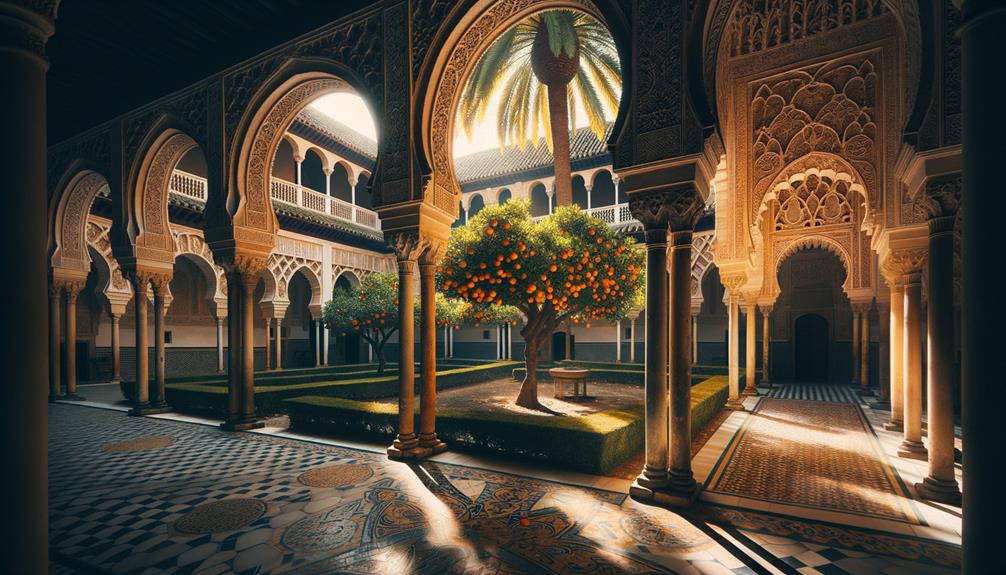
Nestled within the grand arches of the Córdoba Mosque, I stumble upon hidden gems that reveal its layered history and cultural fusion. The Mezquita's architectural styles blend Byzantine and Arabic influences in a fascinating way. As I wander through its majestic domes, I'm reminded of the Aya Sophia in Istanbul, where each arch tells a story of grandeur and resilience.
During a nighttime visit, the intricate decorations and exquisite details come alive under mesmerizing lighting effects. It's as if the Mezquita whispers its secrets, inviting me to explore its depths. Roman milestones and mosaics, hidden beneath the surface, provide a glimpse into the mosque's rich historical layers. These artifacts are more than just remnants of the past; they're pieces of a grand puzzle that illustrate the evolution of this sacred space.
In a quiet corner, I find a starfish fossil, believed to bring good fortune and fulfill wishes. This small, almost unnoticed treasure adds a touch of magic to the Mezquita, a reminder that there are endless wonders waiting to be discovered.
| Hidden Gems | Insights |
|---|---|
| Architectural Styles | Byzantine and Arabic fusion |
| Domes | Reminiscent of Aya Sophia |
| Starfish Fossil | Brings good fortune and fulfills wishes |
Location and Access

Located in the heart of Cordoba's historic center, the Mezquita stands majestically near the Guadalquivir river, making it a focal point that's easily accessible on foot or by public transport. When I planned my visit to this iconic site, I found its location to be incredibly convenient. As I strolled through the charming narrow streets of the old town, the Mezquita's towering presence seemed to draw me in, its historical allure guiding my steps.
Getting to the Mezquita is a breeze. Whether you're arriving by train or bus, you can hop on bus lines 3 or 5, which drop you off close to the entrance. If you prefer exploring on foot, the scenic walk from the city center is both invigorating and picturesque. As I approached the Mezquita, the nearby Guadalquivir river added a serene backdrop to the bustling atmosphere.
To enter the Mezquita, you'll need to pass through the Patio de los Naranjos. Although there are multiple entry points to this courtyard, there's only one main entrance to the Mezquita itself. Depending on the time of day, you might encounter lines, so it's a good idea to plan ahead. This access approach helps preserve the site while allowing visitors to experience its wonders without overwhelming crowds.
Accommodation With Views
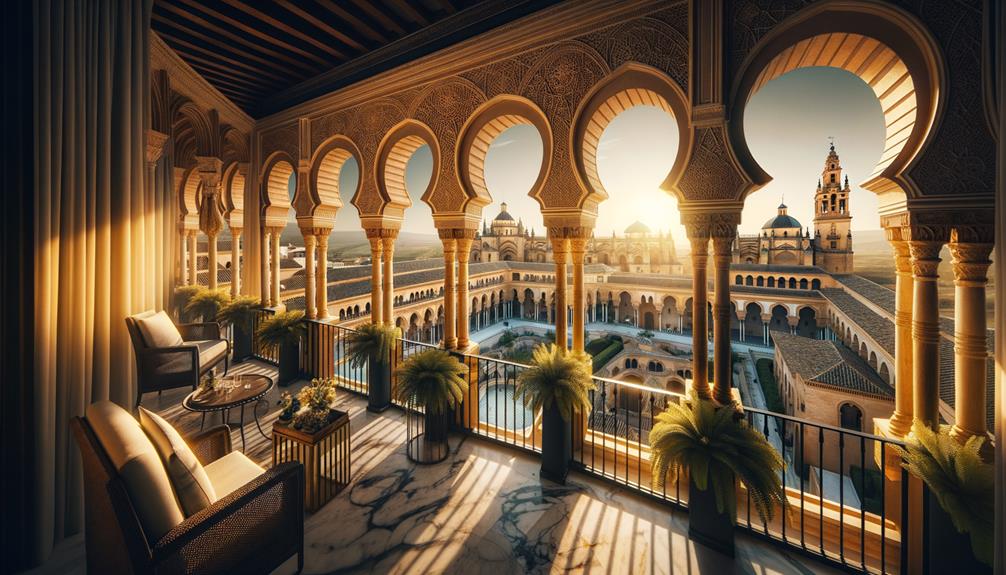
Staying at Balcon de Cordoba, I was treated to breathtaking views of the Mezquita right from my hotel room, an experience that truly enriched my visit. The luxurious accommodation offered more than just comfort – it provided a unique connection to the iconic monument, allowing me to start each day surrounded by its grandeur.
The views of the Mezquita from Balcon de Cordoba were simply unforgettable. Each sunrise and sunset cast a new light on the monument, transforming the scene into a living work of art. The combination of luxurious accommodation and historical charm created the perfect setting for introspection and relaxation.
It felt like I had a personal gateway to Cordoba's essence. The Mezquita's presence was a constant reminder of the city's rich past and vibrant culture.
Relax on the balcony with a morning coffee, gazing at the Mezquita. Take stunning photographs from your hotel room without any crowds. Enjoy an evening drink while the sun sets over the iconic monument. Explore Cordoba's historical sites with ease due to the strategic location.

